|
|
|
Wildlife
Of The Gemfields
The Gemfields of Central Queensland are the habitat of many species of birds and animals that are well known Australian icons. Here are just a few of them...
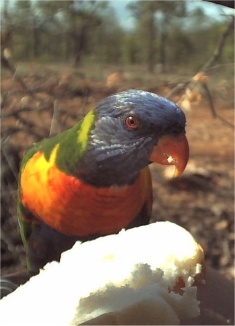 RAINBOW LORIKEET (Trichoglossus haematodus)
RAINBOW LORIKEET (Trichoglossus haematodus)
One of the better known birds of Australia is the Rainbow Lorikeet. Its bold
nature makes it a favourite with tourists.These beautiful, friendly, and
somewhat noisy birds gain their name from their plummage which is every
colour of the rainbow. They feed upon the nectar of flowering trees, and are
one of the largest members of this nectar-eating group of Australian parrots.
 EMU (Dromaius novaehollundia)
EMU (Dromaius novaehollundia)
 MAGPIE (Gymnorhina tibicen)
MAGPIE (Gymnorhina tibicen)
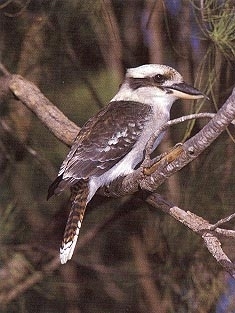 KOOKABURRA (Dacelo novaeguineae)
KOOKABURRA (Dacelo novaeguineae)
Australia's giant laughing kingfisher is one of its best-known birds -
one of the "popular" birds. It is a predator that feeds on any helpless or
small creature it can find, including snakes.
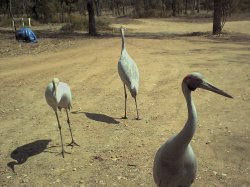 BROLGA ()
BROLGA ()
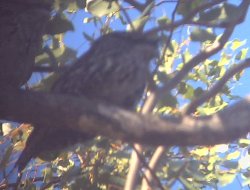 FROGMOUTH ()
FROGMOUTH ()
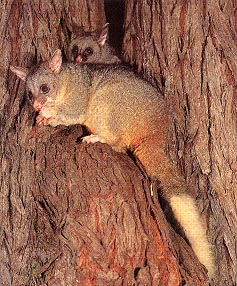 BRUSHTAIL POSSUM
(Trichosurus vulpecula)
BRUSHTAIL POSSUM
(Trichosurus vulpecula)
These nocturnal visitors soon become
quite friendly. Be careful though. The Brushtail Possum is a wild animal and
has very sharp teeth and claws! A comparatively large possum with the typical
hand-like hind feet that distinguish possums, koalas and wombats from
kangaroos, wallabies and rat-kangaroos. It has a large, powerfully built body
with dense fur ranging in colour from grey to reddish-brown. Like other
possums the Brushtail is nocturnal, sheltering by day in hollow trees. It's
an extremely territorial animal with a disconcerting rattling call it uses
to warn other possums away.
 ECHIDNA (Tachyglossus aculeatus)
ECHIDNA (Tachyglossus aculeatus)
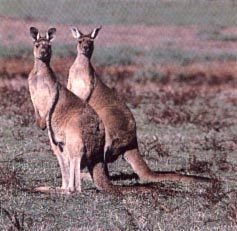 WESTERN GREY KANGAROO (Dacelo novaeguineae)
WESTERN GREY KANGAROO (Dacelo novaeguineae)
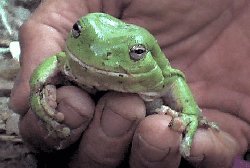 GREEN TREE FROG (Dacelo novaeguineae)
GREEN TREE FROG (Dacelo novaeguineae)
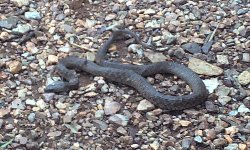 WESTERN BROWN SNAKE (Pseudonaua nuchalis)
WESTERN BROWN SNAKE (Pseudonaua nuchalis)
This snake has a slender body and a small head which is barely
distinct from the neck. The mouth lining is blackish, unlike
the Eastern Brown which has a pink mouth. There are at least
nine forms of this species with a great number of colour patterns.
The basic colour varies from olive-grey to dark brown or
orange-brown. Some forms have a black head and nape, and others
broad dark cross-bands with or without intervening narrower
cross-bands. It is a fast-moving diurnal snake, feeds on mammals
and lizards and is venomous. It is capable of inflicting a potentially
fatal bite.
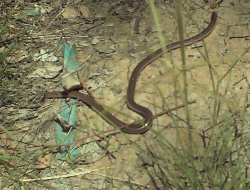 NORTHERN BLIND SNAKE (Ramphotyphlops diversus)
NORTHERN BLIND SNAKE (Ramphotyphlops diversus)
The harmless blind snake can at first appear similar to the
Brown Snake. It is brown to blackish-brown above, grading
quite smoothly into the cream undersurface and is about
25-35cm long. However, it has no discernable "neck" and a
rounded snout.
 BLACK-HEADED PYTHON (Aspidites melanocephalus)
BLACK-HEADED PYTHON (Aspidites melanocephalus)
This non-venomous python is easily recognizable by the glossy black head
and neck. The black pigmentation ends abruptly at the neck
and is replaced by a body colour of cream to reddish-brown
with dark brown cross-bands. It shelters within crevices,
caves, hollow logs or burrows. It is mainly nocturnal but
is sometimes active during the day, feeding mainly on reptiles
but also eating small mammals and birds.
 CENTIPEDE (Dacelo novaeguineae)
CENTIPEDE (Dacelo novaeguineae)